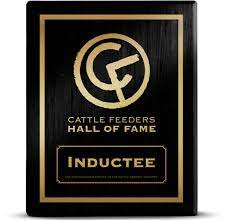By Patti Wilson Contributing Editor

U.S. cattle producers are at a certain disadvantage compared to European stockmen. Why? We are unable to benefit from the use of some new, natural, biological feed additives. Effective compounds have proven to be advantageous in increasing productivity in livestock and reducing negative environmental impacts. While many are certified organic products, some are not. Both organic and conventional feed additives are used most commonly in conventional, non-organic livestock operations.
Central to this problem is the U.S. Food and Drug Administration (FDA), which classifies these feed additives in the same category as drugs. I am not talking about antibiotics; I am referring to non-nutritive products that act only within the gut microbiome. Examples of products in this category would be humates, a compound called 3-NOP, or even seaweed (more on humates later). Europe, Asia, Australia and South America have access to these natural products for use in feed to help improve efficiency and reduce digestive byproducts such as methane. Their country’s updated approval policies have given them an upper hand over the United States in productive and ecological areas.
Here at home, FDA approval of drugs entails an 8- to 10-year process and costs millions of dollars. In the past, certain feed additives were apparently able to be approved in two years. However, since 1998, all are caught up unnecessarily in the tangled web of the federal government. These products are not drugs, but each is evaluated that way in the current Federal Feed Additive petition process. The FDA will not change this problem without Congress implementing the Innovative Feed Act, a piece of legislation currently on the table. The whole issue has become a grey area with the burden of getting products approved so significant that it has proven the system broken.
What Is the Innovative Feed Act?
The Innovative Feed Enhancement and Economic Development (FEED) Act of 2023 is a bipartisan piece of legislation that will allow livestock producers to access new feed products, helping them compete on the global stage and reducing byproducts (think methane). The bill enables the FDA to create a new pathway for approval for feed additives that are innovative without the 8- to 10-year process. Sponsors of the bill are U.S. Sens Tammy Baldwin (D-Wisc.), Roger Marshall, M.D., (R-Kan.), Jerry Moran (R-Kan.) and Michael Bennett (D-Colo.).
Farm and livestock groups nationwide have endorsed the bill. It is considered “too small” to stand on its own and must be added onto a larger piece of legislation (a rider) to pass into law. It may be another year before all the political hurdles have been jumped. So much for our muddied system.
A catch in the dilemma remains that many of the ingredients in these feed products are already safely used in human foods.
In a Jan. 17, 2024, article on agproud.com, Leah Wilkinson, vice president of public policy and education for the American Feed Industry Association (AFIA), noted an additional benefit to the passage of the FEEDS Act. It includes products already on the market that have added benefits that they cannot claim without going through the entire approval process, redundantly. If the FEEDS Act is approved, companies would not have to repeat the entire safety review they’ve already passed to be able to make the new claims.
She explained further how the FDA entanglements evolved. The current policy was put into place in 1998 and deems any product wanting to make a production claim to be regulated as an animal drug. Serious requests to change FDA policy were made in 2020 in an effort to modernize regulatory thinking and give a pathway that could regulate products that truly work within the digestive tract of the animal as feed ingredients. Requests were ignored.
According to Russell Taylor, vice president of Live Earth Products, “Archaic laws are treating everything as a drug and it’s easier to get ingredient approval for human foods than animal feeds.”
Some Specifics About These Products
According to the Humic Products Trade Association website, humictrade.org, “Humates, or humic products include naturally occurring mined materials such as leonardite, oxidized lignite, carbonaceous shales and humates. Humates also can be found in liquid products such as liquid humic acids and liquid fulvic acids, soluble or suspendable powders and gels.
“They are the dark-colored substances that remain after the natural biodegradation of biomatter. Their distinct characteristics are their relative resistance to further biodegradation and highly heterogeneous molecular structure.”
I spoke at length with Live Earth’s Russell Taylor. Taylor’s family has run a humate mine for 35 years. He is also the Humic Product Trade Association president and travels regularly to Washington, D.C., to represent the organic and homeopathic industry.
Taylor describes humates as “old plant deposits, used for different purposes.”
“They fall somewhere in between peat and coal,” he says. “A dark black material, they are soft, have no plant fibers and are comprised of degraded living matter.”
He adds that there are humate deposits scattered in the Dakotas, Utah, New Mexico, Texas and the Florida Everglades. They are often found in close proximity to coal mines. Each humate source yields different percentages and types of organic compounds. These small deposits may be surface mined by family businesses and are typically comprised of 10 to 15 acres. Products developed from humates are often used to reduce odor emissions on hog confinement farms. Research trials have shown that humates can help increase milkfat in lactating cows, bind aflatoxins and mycotoxins, and increase nutrient use efficiency.
Humates provide multiple benefits in a ruminant’s gut; they react with feed to reduce gas emissions and retain ammonia. They reduce protein waste, resulting in less emitted enteric gasses like methane. Manure odor is reduced, as well. The most popular effect being discussed now is methane emission reduction. Humates can help improve gut health; every ruminant animal houses billions of microbes, some are harmful (E. coli, for example).
Other products currently used in human food could be used in animal feeds to help increase food safety. A significant reduction in E. coli bacteria in micro populations results in less chance of the pathogen entering the food chain through contaminated meat products.
Taylor adds his opinion on the European handling of new feedstuffs. It is run by the European Food Safety Authority. Many of the new, natural feed ingredients sitting in U.S. limbo are already listed for use, and European farmers are enjoying the benefits of adding humates to their programs.
Unfortunately the Innovative FEED Initiative cannot be part of the upcoming U.S. Farm Bill. That would be a bit too simple and effective. The livestock feed industry was hoping for this very solution to no avail.
Taylor emphasizes that, although humates are a certified-organic product, most use comes from conventional livestock operations. Other uses involve crop and horticulture entities as well as human consumption.
Taylor is a licensed applicator for fertilizer and soil tests and has been in agriculture his whole life. Taylor raises organic beef and pork in partnership with his father.






